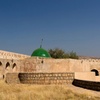Disclaimer
This entry contains information known to us from a variety of sources but may not include all the information currently available. Please be in touch if you notice any inadvertent mistakes in our presentation or have additional knowledge or sources to share. Thank you.
Archive
Cemetery, Koi Senjaq (Koy Sinjaq), Iraq
The former cemetery in the Iraqi Kurdistan city of Koi Senjaq/ Koy Sinjaq/ Koy Sanjaq (Koy Sanjaq, کۆیە, Koye, Koya, كوي سنجق, כוי סנג’ק), Iraq.
Currently in most of the Kurdistan Iraqi region, Jewish synagogues and public areas for praying and communal activities are non existent. This suggests that the cemetery in Koy Sanjaq may no longer be in town .1
Jewish burial customs are unique to each town or village. Below are some general customs shared amongst the Jewish communities of Amadiya and Zakho in the Kurdistan region of Iraq. Amadiya, Zakho and Koy Sanjaq are within a four to six hour drive of each other. In Amadiya and Zakho, the cemeteries are outside the towns. 2 The coffins are not used for burials, instead the body is laid down on a “bier” which is a movable frame that is held together by Koitwo poles parallel to each other, tied down with ropes. 3
Cemeteries for Jewish communities in Kurdistan tend to be in the outer area of the city’s wall. Cemeteries have no fences surrounding them and there are no tombstones marking grave spots. The mood that the state of these cemeteries invoke is of “unrelieved desolation.” From afar cemeteries might look completely neglected or be masked as stony fields. 4
Description
The Jewish Community of Koi Senjaq
There are around 200 Jews in this town in the Iraqi region of Kurdistan. They speak the Neo-Aramaic language. In 1947, the total number of Jews in the town of 8,198 people was only 268. There were 7,746 Muslims and 184 Christians. Many Jews had escaped in the middle of the 20th century due to the hostile attitude towards them by the Islamic political environment. This town is generally called Koy by it’s Jewish and Christian population. The town had a few name changes before the Islamic political sphere began governing Kurdistan. It was once known as Koshar. After the Muslim political rulers took over the Kurdish region, it came under the name of Kohsar. It was not until the Ottoman empire came to fruition did it gain it’s name of Koy Sanjaq. This town was a military fortress, and its name in Turkish means “village of the flag”. It is said that Jews eventually moved to the area to give services for the soldiers who were living in the area there.5
There is relatively little known history on the Jews in Koy Sanjaq. They have been mentioned in a few historical documents by people such as Rabbi Yosef son of Rabbi Yahuda in the 18th century. Most of their notable accounts have been over financial transactions and documentation of Jewish literary work in Koy Sanjaq. In the book compiled by Rabbi Yosef, prayers, hymns and topics of Jewish mysticism and law are also documented.6
Economically, most of the men participated in the weaving, tailoring, dying trades, as well as being goldsmiths and merchants. There were a few who worked in the agricultural sector.7 Because the Jews in this area tended to lead a more isolationist life concerning religious and cultural matters, they were often discriminated against by their neighbors especially the Kurds. However, in most cases they were not subject to persecution because of their well-known services to the town’s economic system.8
After the middle of the 20th century when many Jews immigrated to Israel, most of the town’s Jewish population moved to villages in areas such as Shtula, Elqosh and Noga ( the two are in Galilee) and Noga (in the area of Negev). They also moved to the towns of Nahariyya, Ashqelon, Ashdod and Bay-Yam.9
Today there is not much literary documentation on the town of Koy Sanjaq, but the people who live in Koy San Jaq have made a tourist social media site for their town. For more info visit https://www.facebook.com/places/Things-to-do-in-Koy-Senjaq-Arbil-Iraq/109480582409916/.
Maria Langen is also a photographer who is a part of Sverredal and Langen Gallery. She has created a photo project documenting the people and landmarks of Koy Sen jaq. Her photography can be viewed at http://www.svelan.com/World-Projects/Iraqian-Kurdistan/i-fdRgQSf.
Sources
Footnotes:
1] Hollie McKay, “Iraq’s Kurds urge Jews, other religious minorities to come, practice faith,” Fox News World, May 9, 2016, (accessed July 22, 2016). http://www.foxnews.com/world/2016/05/09/iraqs-kurds-urge-jews-other-religious-minorities-to-come-practice-faith.html
2] Erich Brauer, The Jews of Kurdistan (Detroit, Michigan : Wayne State University Press, 1993, (accessed July 22, 2016), 199.
3] Erich Brauer, The Jews of Kurdistan (Detroit, Michigan : Wayne State University Press, 1993, (accessed July 22, 2016), 198.
4] Erich Brauer, The Jews of Kurdistan (Detroit, Michigan : Wayne State University Press, 1993, (accessed July 22, 2016), 202.
5] Hezy Mutzafi, The Jewish Neo-Aramaic Dialect of Koy Sanjaq(Iraqi Kurdistan) ( Germany: Otto Harrassowitz KG, Wiesbaden, 2004), (accessed July 22, 2016)1-5.
6] Ibid.
7] Ibid.
8] Ibid.
9] Ibid.
Bibliography:
Hollie McKay, “Iraq’s Kurds urge Jews, other religious minorities to come, practice faith,” Fox News World, May 9, 2016, (accessed July 22,
2016). http://www.foxnews.com/world/2016/05/09/iraqs-kurds-urge-jews-other-religious-minorities-to-come-practice-faith.html
Erich Brauer, The Jews of Kurdistan (Detroit, Michigan : Wayne State University Press, 1993, (accessed July 22, 2016), 199.
Hezy Mutzafi, The Jewish Neo-Aramaic Dialect of Koy Sanjaq(Iraqi Kurdistan) ( Germany: Otto Harrassowitz KG, Wiesbaden, 2004), (accessed
July 22, 2016)1-5.
Coordinates provided by Joseph Samuel.
For more on Koi Senjaq, see אנציקלופדיה של יהודי כורדיסתאן, Encyclopedia of the Jews of Kurdistan by Mordechai Yonah, p. 132-134.

